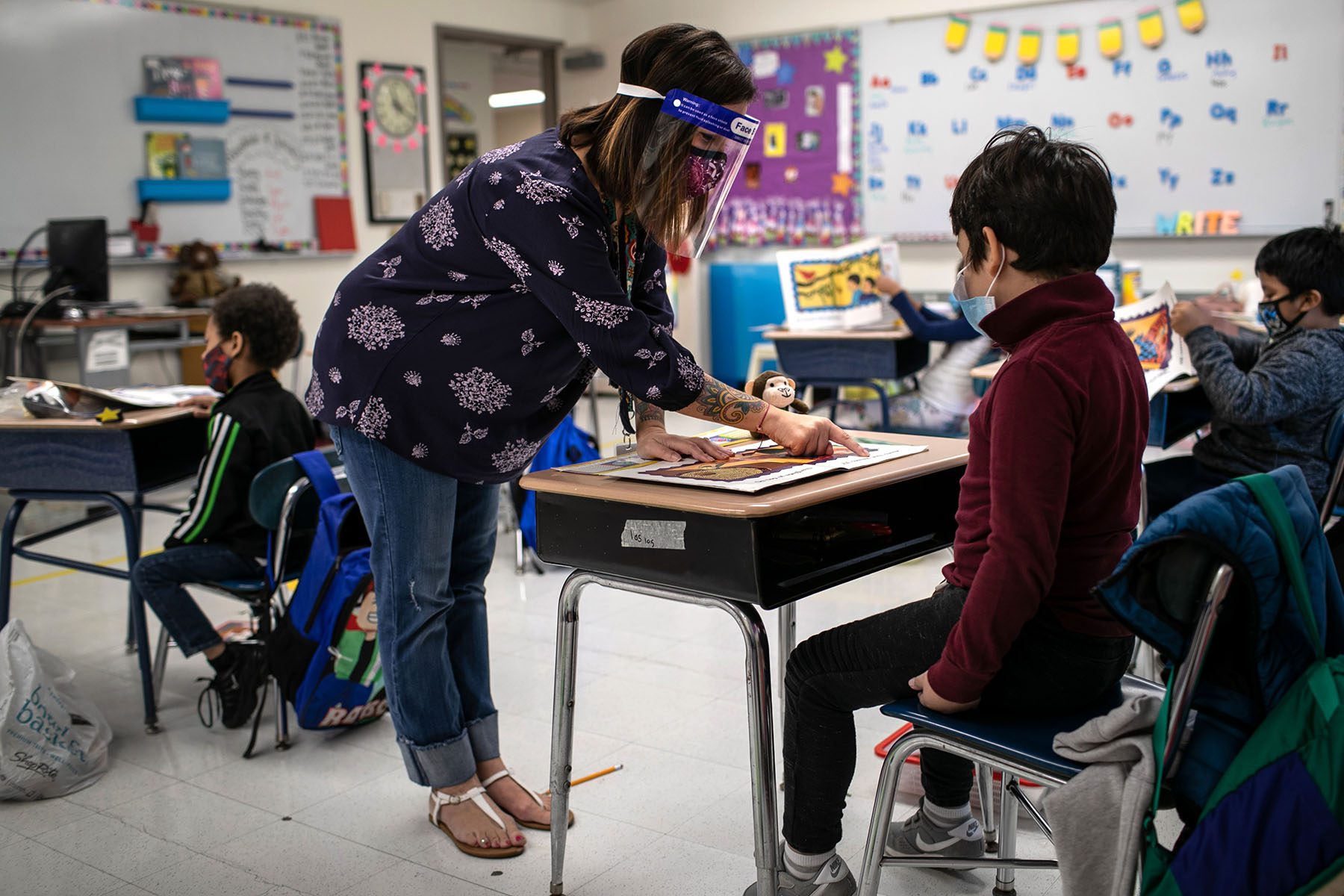Legislators in at least 15 states, including Kentucky, Missouri, New Mexico and Colorado, have in 2021 either proposed raising teacher pay or already done so, part of an effort to combat a national teacher shortage that’s been brewing for years.
The efforts to increase pay are coming from both red and blue states, many of them desperate for educators after the pandemic prompted some veteran teachers to retire without newcomers to replace them. States are trying to retain existing teachers and attract beginners to the profession in a political climate that’s seen educators targeted by parents and policymakers who object to children learning about the history of social injustice in class or to schools enforcing mask and vaccine mandates during the COVID-19 pandemic. The push for more teachers is also coming from the federal government, as President Joe Biden’s Build Back Better Act, currently under consideration in the Senate, sets aside $112 million to counter teacher shortages in key subject areas and high-needs schools.
Governors of the two states with the lowest average teacher pay are both proposing raises next year. While the national average public school teacher salary is $64,133, according to a 2021 report by the National Education Association (NEA), teachers in South Dakota are paid on average under $49,000; in Mississippi, it’s just under $47,000. More than three-quarters of teachers in the United States are women.
In November, Gov. Tate Reeves of Mississippi, a Republican, released his executive budget recommendation for fiscal 2023, which starts in July, proposing giving teachers a $3,300 raise over the next three years. On December 7, Gov. Kristi Noem of South Dakota, also a Republican, presented her 2022 budget proposal, which includes a 6 percent pay raise for teachers and other state workers.
“We can’t invest in our workforce without supporting the hard workers that we already have here,” Noem said during her presentation.
The state legislature would have to approve Noem’s proposed pay bump for it to take effect, but Loren Paul, president of the South Dakota Education Association, told The 19th that the would-be raise “is huge.”
It’s not enough, however, Paul said: For consistent progress to be made in education, teacher pay must keep rising. Also, he said, the proposed pay hike doesn’t address the many problems South Dakota’s education sector is experiencing during the pandemic.
“There’s a national teacher shortage,” he said. “But, here, in South Dakota, there’s an educator shortage. We are short bus drivers, paraprofessionals, cooks, custodial staff, teachers. We are short every education position there is.”
The teacher shortage in South Dakota, or nationwide, isn’t new. It’s in part an outgrowth of the Great Recession that began in late 2007, which ushered in education budget cuts resulting in a dearth of available teaching jobs around the country. Fewer college students pursued education careers, and as teachers have retired or resigned from the profession, there aren’t enough teachers to go around, especially in regions where enrollment has grown.
Frustrations with pay and teaching conditions led teachers across the country to strike in 2018 and 2019, but South Dakota educators sat out these actions because state law prohibits teacher walkouts. At least 22 governors recommended educator pay hikes in 2019, a year that Noem did not recommend raising teacher pay in South Dakota. Although the state introduced a half-cent sales tax to raise teacher wages to address a 2016 teacher shortage, it continued to rank near the bottom of the nation in average teacher salaries.
The state’s low teacher pay — and what they and their classrooms are lacking — drew new attention this month after a “Dash for Cash” event at a Sioux Falls hockey game, in which teachers crawled to compete for cash for school supplies, led to widespread public outcry. On average, teachers spent $750 of their own money on school supplies during the 2020-2021 school year, according to an AdoptAClassroom survey of 5,400 educators.
“It may have been well intentioned, but it does underscore the fact that educators don’t have the resources necessary to meet the needs of their students,” Paul said of the Dash for Cash event.
Virginia ranks 26th in average public school teacher salary, with an average pay of just under $58,000 a year. It’s also facing a teacher shortage, and outgoing Gov. Ralph Northam, a Democrat, has proposed raising teacher pay by 10 percent over the next two years. Whether that happens will be up to the new General Assembly and Governor-elect Glenn Youngkin, a Republican who made education a key component of his campaign and has also promised to raise teacher salaries.
“The teacher shortage is particularly acute in certain areas,” said Jonathan D. Becker, associate professor of educational leadership at Virginia Commonwealth University’s School of Education. “We need more special ed teachers. We need more teachers who can work with English language learners.”
A Brookings Institution analysis of a survey given to 1,045 teachers in March found that the number of teachers nationwide uncertain that they will spend their careers in education has increased from the year before. The same is true for the number of teachers who say they plan to leave their current state or the education profession in the next five years. While 34 percent of teachers nearing retirement say they’ve considered leaving or retiring because of COVID-19, compared with 23 percent for all respondents, both older and younger teachers were equally as likely to report that they’d considered leaving education for reasons unrelated to the coronavirus.
During the pandemic educators have faced multiple challenges, including teaching off- and online, sometimes simultaneously. The shift has required them to adapt their lesson plans and spend more time on them. Teachers have also been tasked with enforcing social distancing and mask mandates in their classrooms, new responsibilities that have sometimes exposed them to irate parents and threats of violence. Also, as states and school districts pass policies that limit what educators can say about social injustice in class, some teachers fear they can no longer speak candidly about the nation’s history.
The more negative attention education receives, be it from debates over vaccines or critical race theory, the more difficult it is for schools to attract and retain teachers, said Becker, who instructs teachers enrolled in VCU’s graduate education program.
“Teachers are not doing well right now,” he said. “They are bone tired. They’re exhausted, and now they’re bearing the brunt of the public’s attention in unpleasant ways.”
Amid staffing shortages and a political climate that’s placed teachers under great strain, school districts across the country have begun closing periodically to allow students and staff to take time off for the sake of their mental health. Citing concerns about his employees’ emotional wellbeing, Richmond Public Schools Superintendent Jason Kamras announced that schools in that Virginia district would close the week of November 1.
“I worry about significant staff absences …, which could make it very difficult for us to follow our COVID-19 distancing protocols, putting student and staff health in jeopardy,” Kamras said in a statement, apologizing to parents for closing schools on short notice.
The school district received pushback for its decision, but Becker said that districts have few options other than to occasionally close considering their staffing issues. He hopes that Virginia teachers receive a pay raise, which could boost their morale and add to their ranks in the commonwealth.
“Teachers, for the most part, aren’t in it for the money,” he said. “But, in Virginia, they are not paid well compared to other teachers around the country. So if we care about teachers, want more teachers in the pipeline and for teachers to stick around, then we need to pay them better.”







